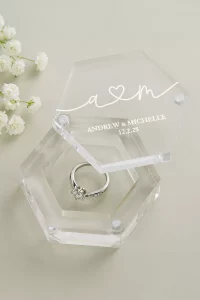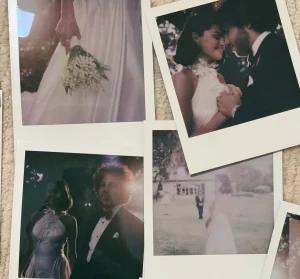From Julia Holm of Great Day Events:
Numbers are a topic that can be fun and exciting for some of us, but sensitive and stressful for many of us.
In thinking about what I wanted to share today, there was SO MUCH that came to mind about this topic because so much of planning and the tips and advice I could offer relate to the budget…but today I thought I would really just hone in on how to build a wedding budget and the basics of managing it successfully.
I like practical, tangible, usable information, so that is what I plan to share today. It’s going to be full of numbers and examples and valuable information, and you’ll want a notebook to write it all down.
Building a Wedding Budget
There are a plethora of factors that contribute to building a wedding budget. Some of these factors are what make planning overwhelming, stressful, or causes it to become a point of contention.
- Who is contributing to the budget and how do they want their money to be used and how much control do they want over that area of the planning.
- How many guests does the couple want to invite and what pressure regarding their guest list are they receiving from others who may be contributing financially?
- What categories do the couple want to consider as part of their actual wedding budget keeping in mind that there are a lot of events related to the wedding outside of the day-of that may incur expenses like bachelor/bachelorette parties, showers, rehearsal/rehearsal dinner, a welcome reception for out-of-town guests, day-after brunch, etc.
- Agreeing on what the priorities are versus what are the areas to save. The budget may stretch some of the priorities and there may be some areas of sacrifice or DIY work where it’s not a priority. Agreeing on what are potentially the sacrifices we are going to make and what are we agreeing to splurge on?
Building the wedding budget with clarity and understanding as many factors as possible before we start spending, makes managing the budget easier and less stressful.
We start all of our clients with a Planning Tool Kit. One piece of the tool kit is a budgeting tool that outlines a wedding budget for them in a really nifty software system and makes it very simple to keep it organized. This is one of the ways we like to set our clients up for success from the time they book with us, regardless of their level of service. But unless they hire us to help manage their budget and book their vendors, it is really up to the couple from there to approach their budget management with diligence and wisdom. So I am just going to walk you through a sample step by step budget-building process.
Step 1: Set the target budget and decide who will pay for what.
- This is something that couples will want to do as one of their first steps – before booking anything – at least for most couples. Far too often people set a really general budget that stays very vague for far too long into the planning process until it becomes stressful because some vendors have already been booked and they are left crunching numbers to try to squeeze in some final elements they hadn’t considered.
Misconception #1:
From the start, there is a perception that what feels like a large sum of money will go a long way, which causes a couple to spend with more freedom in the beginning.
But, the concept of what can be achieved with $25,000 can quickly become a reality check moment when it disappears quickly without proper planning. Not everyone has planned an event at this scale, so often you become educated as you go, but in a difficult way because money is on the line. First of all, we have to understand what a realistic budget is to achieve our vision.
- The Knot says that the average MN wedding costs between $22-25K. National average is $30,000-35,000.
- Also in MN, the average couple spends nearly 12 months planning. The length of time a couple plans may contribute to how much they want to spend since they may be able to invest more over time.
- In MN, 42% get married in the summer, 38% choose the fall, 15% choose the spring, and 5% choose winter. Pricing tends to go down in the offseason.
Step 2: Name the wedding budget categories and list the general sub-categories that might fall under those main categories.
Step 3: Assign appropriate percentages of your overall budget to each category.
Let’s consider the amounts with a $25,000 budget.
- Attire 7% ($1750)
• Pre-wedding attire (wedding showers, bachelor/bachelorette parties)
• Engagement photo outfits
• Wedding day attire for both partner 1 (3.5% = $875) and partner 2 (1% = $250)
• Alterations and steaming
• Special undergarments
• Shoes, veil, and accessories - Beauty/Grooming 2% ($500)
• Hair (include trial appointment)
• Makeup
• Spa Services (waxing, spray tan, nails, etc.) - Event Planner/Coordinator 7% ($1750 – month-of service, maybe a bit more into partial planning)
- Miscellaneous Fees/Extras 3-5%
- Favors/Gifts 2% ($500)
- Floral and Decor 8-10% ($2000)
• Florist
• Rentals - Food/Beverage/Venue 50% ($12,500)
• Ceremony
• Reception
• Food
• Beverages
• Dessert, Dessert Stands, Cake Topper ($500 – includes desserts, stands/display, set up/delivery, cake topper)
Misconception #2:
Pricing from venue to venue is easy to understand based on the numbers that the venue posts – false.
Be mindful of how a venue lists their pricing and what is included in that pricing. Is there a rental fee-only? If so, you would hire outside vendors for food and beverage – preferred list versus freedom to choose your own. Is there a food and beverage minimum only? What if there is a food and beverage minimum? How realistic is it for your guest count? Ask for a sample order based on buffet/plated/family style. Is there both a rental charge and a food and beverage minimum? Are there separate charges for the ceremony site, reception site, additional hours, or certain amenities?Our building-a-wedding-budget outline breaks down about how much you should expect to spend in each of these individual areas (ceremony site, reception site, dessert, food, beverage).
Also, remember that when you are paying for food and beverage, you are not only paying for the actual food and drinks, you are also paying for the service staff, the table settings, and there are service charges and gratuities of 18-22%.
I know it’s a lot the think about and it seems overwhelming, and the thing is it does take a lot of research and time to learn and detect these things, which is where someone like a planner with a venue finder service may be a great benefit.
- Invitations/Print Work 1.5-2% ($500)
• Save-the-Dates
• Wedding Invitations
• Programs - Lodging 0.5 – 1% ($125)
- Music 6.5-14% ($1625-3500)
• DJ
• Band
• Live Ceremony/Cocktail Hour Music - Photography/Videography 10-15% ($2500)
- Transportation 2% ($500)
• Guest Transportation
• Bride and Groom
• Wedding Party
**Notice we did not include any outside of wedding day events in this budget. It is also not counting in the rings, marriage license, or many other non-day-of expenses. Obviously, vendor amounts are not all going to fit perfectly into these dollar amounts, so there is some natural adjusting.
Step 4: Among those categories, recognize where your priorities lie and where you might want the percentages to adjust.
As you research, meet with vendors, receive proposals, compare and negotiate, you will get a more realistic picture of how those percentages will shakedown for you. This is where a planner can be very helpful with directing you toward the right vendors to fit your style and budget. For example, if we find a photographer that you love that is $500-$1000 outside of your budget then maybe we decide to nix transportation and simplify decor a little bit. If that trade-off is worth it to you then it was a good decision.
Boom! Now we have an Estimated Budget. This is a step that a lot of people skip but it is the biggest thing that will set you up for budgeting success because it gives you a starting point for how to choose your vendors. It will ultimately save you time and stress.
Wedding Budget Management
Now that we have built the budget, let’s talk about managing it.
We have three main divisions in our budget tracking process, which are Estimated (as you have seen, is setting us up well), Negotiated, and then Actual.
- Negotiated column is for the initial proposals you receive and the price of the vendors you have decided to book.
- Actual column is the final price that is paid in the end. Several vendors will have one set price – like photographers, a DJ, or a coordinator – unless you decide to add on hours in the end or something. Other vendors may see an adjustment from the initial, negotiated estimate in the end because of your guest count changes – most often it drops which means you need fewer meals, fewer centerpieces, etc. These vendors are like the florist, the caterer, the rental company. You always have the freedom to alter these proposals even after you book with the vendor up until around the month of the wedding.
Misconception #3:
Surrounding the idea that the number of guests doesn’t affect the budget as much as it actually does.
Being a coordinator, I find it to be a really important part of my job to help paint an accurate picture for my clients of how their ideas might actually play out – the potential positives and negatives – and allow that to help them make a final decision.
Minnesotans like to have big weddings, which can be a beautiful thing! We have big families, love people, are friendly and welcoming and want an inclusive celebration. For many of us, having our people there is what matters the most to us about the day. We can always do our best to find a way to make that work with the budget we have.
This is in no way to deter couples from making that choice. But I am just here to drop truth bombs.
The truth is that the size of the guest list is very likely one of the leading factors in the overall cost.
When you consider that the average food cost per person is around $70…then you add in beverages if you are hosting, and potentially multiple other things (favors, rental chairs, etc.)…$100 per person is not an unreasonable assumption. Of course, it is very possible to come in well under this number and also very possible to far exceed this number.
Make sure you are getting those RSVPs a month in advance so you have time to call around and get your vendors accurate numbers at least 2 weeks in advance, which is when a lot of those guest-count dependent payments are due. You could be saving yourself a lot.
For instance, let’s say you originally planned for 300 (BEO proposal $30,000) people but 225 RSVP yes in the end ($5000). That also means 75 fewer people consuming beverages. 7 fewer tables of centerpieces, 75 pieces less of each rental item if you have a rental order. All of that really begins to add up. So you can only imagine if you started with 225 and actually 170 people RSVP yes…well, now our event is coming close to nearly half of the cost of the original 300 person proposal.
When it comes down to it, one major way to save money is to shave your invitation list from the beginning. However, I will always come back around to 100% supporting the couple’s investment in what matters most to them. If it is those 300 people, by all means, let’s have the loved ones present. No matter what, it is important to consider guest count when building a wedding budget.
Other Helpful Tips:
- From the start take note of deposit amounts, final balance amounts, and due dates.
- Put notes in your budget and reminders in your calendar of when and how those amounts are due. Every vendor takes payment differently. Some are by check sent to a certain address.
DIY
I am a saver. I like a good deal and don’t shy away from a DIY project, which I have learned by working with MN couples that is very Minnesotan of me. We here in the hardworking Midwest like to take on as much as we possibly can for some reason. Your wedding planning is there to help clients find a good deal if that is what they are looking for. DIY may not always save us sanity and it is certainly not going to save us work or time. So you have to weigh your options when building a wedding budget for your time and money.
Final Thoughts:
- There is a common trend of overspending in America. I had only TWO couples this year stick to their wedding budget.
- Preparation and attitude surrounding the budget plays a huge role in the couple’s enjoyment of the planning process.
- Invest in what matters.
For more information on Julia and building a wedding budget, check out:
Website: https://www.greatdayeventsmn.com/
Instagram: https://www.instagram.com/greatdayevents/
Facebook: https://www.facebook.com/greatdayevents
Listing: https://foreverbride.com/vendors/wedding-planners/great-day-events-2












